Authoritarian states: Mao's China
1/88
Earn XP
Description and Tags
Name | Mastery | Learn | Test | Matching | Spaced |
|---|
No study sessions yet.
89 Terms
Mao Zedong
Mao Zedong (1893-1976) was an authoritarian dictator who ruled China from 1949 until his death in 1976. Mao’s legacy is mixed: he was a brutal ruler who was responsible for the death of millions of people, but he also introduced many aspects of the China we know today.
The Qing Dynasty, 1644-1912
China’s last imperial dynasty, overthrown in the ‘Double Tenth Revolution’ of 1911
The Qing were Manchu (as opposed to Han Chinese) from the far north (an area called Manchuria)
The Qing kept many Chinese social structures but also introduced some of their own
After a period of stability, in the late 1790s the Qing Emperor Qianlong began to make erratic decisions which sparked peasant revolts- this became an ongoing issue and was a major factor in destabilising the Qing
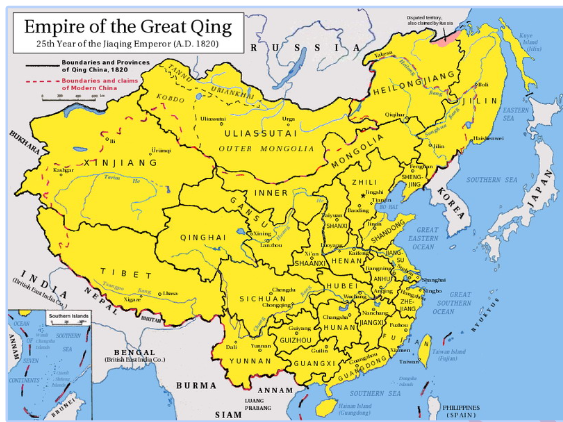
“mandate to heaven”
Permitted the emperor in the Qing Dynasty to put down any opposition/ threats to power
What was the impact of the presence of foreign imperialists in the 19th Century?
Increasing presence of foreign imperialists in China provoked resentment against Qing (Manchu) Dynasty.
Led to large-scale rebellions which imperial rulers struggled to contain
Most Serious rebellions were;
The Taiping Rebellion (1850-1864)
The Boxer Rebellion (1898-1900) (Boxers murdered missionaries + Christian converts but were eventually crushed by a 50000 international relief force from foreign powers)
Imposed a $330 million fine on China → Fueled bitterness
The Opium Wars - Introduction
Britain attempted to balance this control by introducing Indian Cotton as a commodity which it hoped would be in high demand from Chinese - but this was not successful.
British merchants then hatched another plan in the late 1700s, and began to smuggle opium - a highly addictive drug - into China, which became in high demand soon enough. The opium was sold through Chinese gangs and merchants who got a share of the profit.
The opium trade was now benefiting Britain, making large profits. About 10 million Chinese people became addicted to opium, spending their days in opium dens.
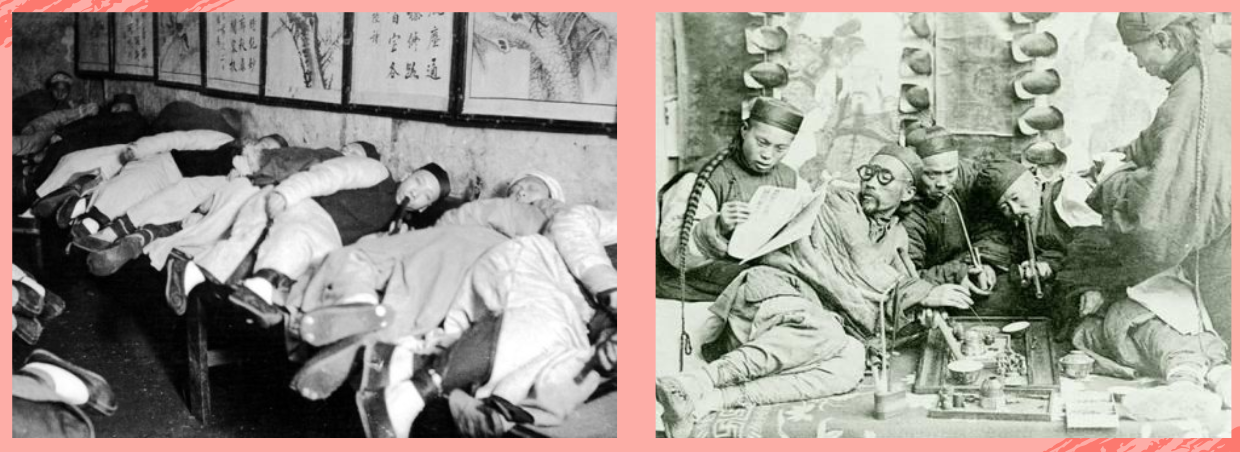
The Opium Wars - Reaction/ Crackdown
In 1813, the now-Emperor Daoguang (Qianlong’s grandson) banned opium but the illegal trade continued into the 1830s, only growing.
Imperial Commissioner Lin Zexu was put in charge of dealing with the problem. He ordered part of the top lip of opium addicts to be cut off to stop them using pipes!
Britain’s refusal to stop the trade, as well as their disregard for the social problems it had caused, resulted in the outbreak of the First Opium War.
“Critics compared the opium trade to the recently banned slave trade. The London government almost fell. In China, the Opium War gradually came to be seen as the beginning of a century of humiliations at Western hands.”
The First Opium War 1832-42
China suffered successive defeats and eventually signed the Treaty of Nanjing. This was a significant turning point as it granted the British advantages:
British were not subject to Chinese courts; Hong Kong became British; access to 5 important ports for trade and abolition of Cohong system; reparations payments; ‘Most Favoured Nation’ status (economic favour)
Australian historian Gwendda Milston: ‘...to the English it was not a war about opium, but a war to establish their right to trade under conditions they were accustomed to elsewhere.’
The First Opium war was the start of what became known as China’s ‘Century of Humiliation’, which didn’t end until the CCP’s victory in 1949.
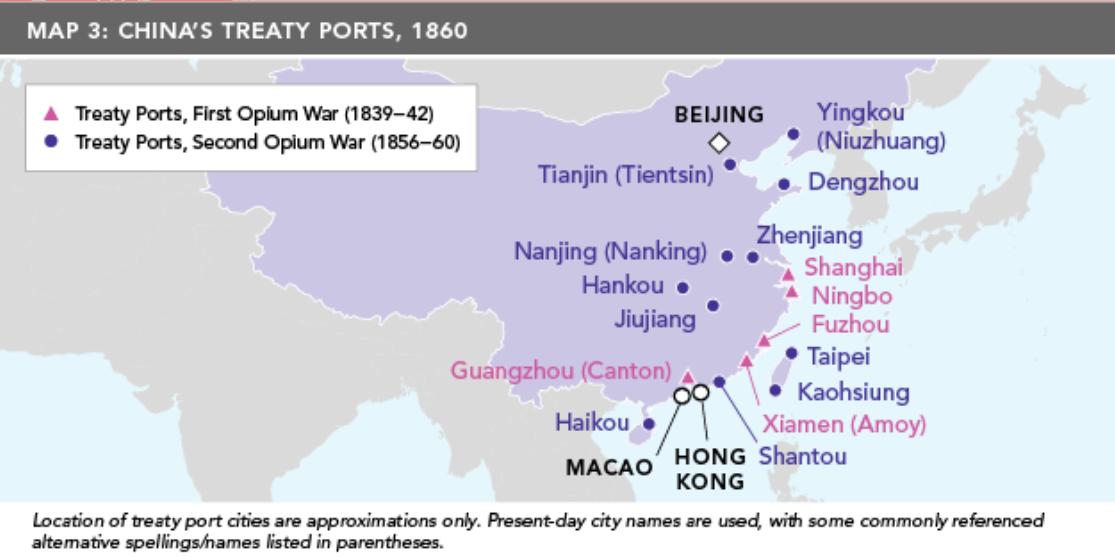
The Second opium War 1856-60
Britain and France together defeated China again. Treaty of Tianjin was signed:
More access to ports; France also granted ‘most favoured nation’ status; missionaries granted rights; the opium trade was legalised
Though signing the treaty was seen as shameful act of Qing by many Chinese, the treaty had at first been refused and the British delegation arrested, but Britain responded by sending in military to force compliance
Emperor Xiangfeng fled Beijing; he was viewed to have wasted his yang (masculine energy). British and French destroyed the capital.
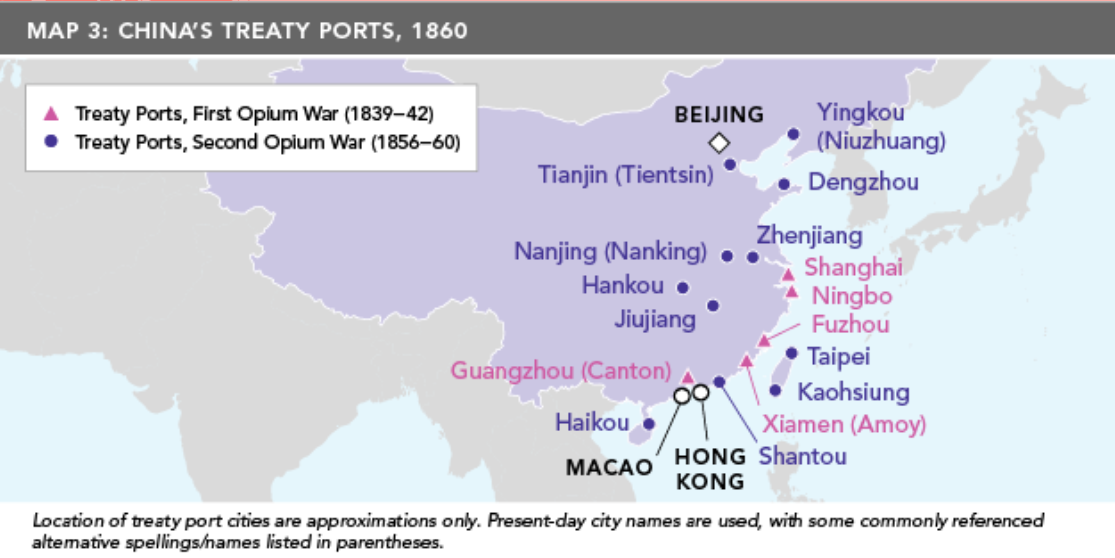
The fight for China
Between 1895-8 Britain, Germany, France, Japan and Russia all fought for ‘spheres of influence’ in China.
In 1898 and 1899, China was on the point of partition between the imperialist powers.
Russia forced the Japanese out of Manchuria
Germany occupied ports in the Shandong Peninsula and the British took Weihaiwei. They also gained a 99-year lease on the Kowloon Peninsula.

The hundred days of reform
When Prince Gong died in 1898, Emperor Guangxu had a chance to implement sweeping reforms.
Between June and September he issued a series of decrees covering the following:
New schools based on Western and Chinese learning
End of Confucian examinations for aspiring public servant
Removal of unnecessary Imperial departments
Adoption of modern military drill for the armed forces
More thorough accounting for court spending
Support for new railways and farming methods
Investment in mining and commerce
The right of ordinary citizens to petition the Emperor directly
Consultation with the Japanese on methods of reform
Empress Cixi and her reaction to reform
However, not everyone agreed with the modernisation reforms. China still had a number of influential Confucianists who opposed the Hundred Days of Reform (which they viewed as attacking traditional Chinese culture).
Seeing this unrest as an opportunity to seize power for herself, Cixi orchestrated a coup against Guangxu. He remained under house arrest until his death in 1908.
Cixi immediately began to stop the reforms and purged the Qing court of anyone who was pro-modernisation. However, this came with significant consequences for the Qing…
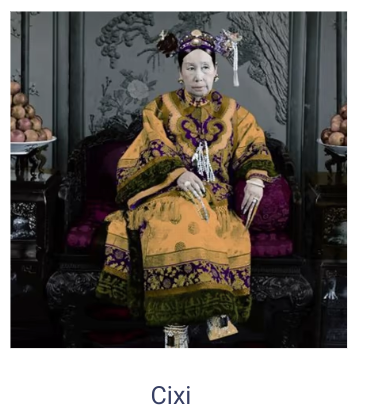
The Boxer rebellion and its implications
Originally, they were opposed to all foreigners including the Qing
In 1898 they were given approval by a Viceroy in Shandong.
In September 1899 they began to attack all things foreign: around 250 Westerners and countless Chinese lost their lives.
From late 1899 to mid-1900 a series of Imperial edicts encouraged them
by June 1900 they had reached Beijing.
Tensions escalated and the British moved troops to Beijing but they were pushed back.
On 21 June Cixi declared war on the foreigners.
The Boxers, with imperial troops lay siege to the foreign legations in Beijing.
A nine-nation force of 18 000 easily defeated the Chinese by 14th August 1900.
Beijing was pillaged and looted and Boxers were decapitated in great numbers.
Sun Yat Sen
Leader of the 1911 revolutionary uprising and leader of young revolutionaries (mainly townspeople, students + peasants).
His revolutionary league, founded in 1905 was built on 3 principles:
Nationalism
Democracy
Improving peoples livelihoods through socialism
1911 Revolution
Revolutionary conspiracy spread in Southern army units, → Toppling of Qing rulers
Revolutionary alliance in Nanjing appointed Sun yat sen as president, but weren’t strong enough to wrest control away from the imperial government →needed military support
Cemented deal when Yuan Shikai, the most powerful imperial general promised to support the revolution on the condition he took over as president
Infant emperor Puyi abdicated forming the Republic of China
Yuan Shikai + Republic of China
Called for parliamentary elections in 1913
When the revolutionary alliance (now the GMD) won elections he banned them
Shut down parliament in 1914 and ruled China as an emperor
1915 submitted to most of the 21 demands imposed by Japan → Included German privilege to Shandong to Japan + allowing Japan to exploit mineral resources in Southern Manchuria
Died in 1916 leaving China Weak + divided
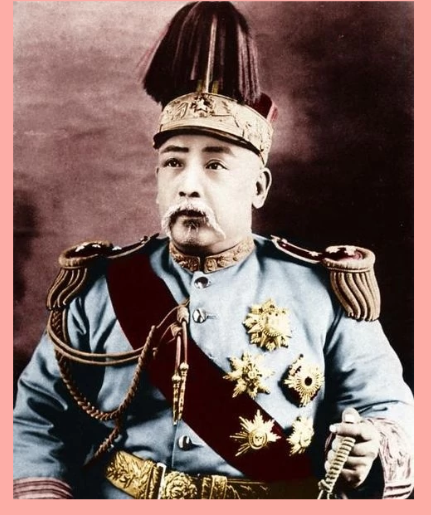
KMT/GMD
KuoMintang/Guomindang
CCP
Communist Party of China
The Warlord period 1916-1927
No effective central government in China
Power in the hands of regional generals/ warlords
Had high taxes and lands were looted/pillaged often
Anarchy + division made it easy for foreign powers to interfere
China weakened by the loss of Tibet, Xinjiang + Outer Mongolia
The May Fourth Movement 1919
End of WW1 increase Chinese humiliation
China provided allies with 95000 labourers to help with the war effort in 1916 and many died on European soil
Given with the expectation Shandong would be returned after Germany’s defeat
Treaty of Versailles in 1919 gave Japan the German concessions in China
Prompted nationwide demonstrations + Student protests in Beijing on May 4 1919
Denounced the 21 demands
Protestors felt betrayed by Western powers + Japanese expansionism
Emergence of Mao + CCP
CCP formed in 1921, led by Chen Duxio + Li Dazhao encouraged by Comintern
Mao was a founding delegate and was a Marxist convert
Comintern
Communist internation → set in 1919 Moscow to spread communism worldwide
The First United Front
CCP + GMD enouraged to form alliance by GMD
Ideological conflict but united goal to defeat warlods
Formed the First united front in 1924
Supported by establishment of Whampoa milotary academy → providing a military force to support GMD’s political aims
Chiang Kaishek
Leader of United Front after Sun Yat Sen’s death in 1925
Right-leaning and suspicious of CCP
The Northern Expedition 1926-28
100000 men left Guangzhou in 1926 May to conquer Fujian, Jiangxi + Nanjing
Made rapid advances against the warlords
With successes of taking being poised to take over Nanjing + Shanghai tensions rose
Chiang saw communist activism as a threat because it would undermine middle-class support
Mao’s return to Hunan 1926
Organised peasant association to support the UNited Front campaigns
Seen as a leader against the warlords + landlords
The White Terror 1927
Chiang Kaishek wanted to reassert authority + GMD supremacy
Used support of landlords, warlords, secret societies + criminal organisation to ‘purge’ communist organisations in Shanghai
Followed by violent confrontations in Wuhan + Hunan
United Front collapsed, Manchurian Warlord Zhang Zoulin seized control of beijing + joined forces w Chiang
Wang Jiwei renounced GMD leadership + supported Chiang
Chiang established nationalist government in Nanjing
The Nanjing decade
The Nanjing decade is an informal name for the decade from 1927 to 1937 in the Republic of China. It began when Nationalist Generalissimo Chiang Kai-shek took Nanjing from Zhili clique warlord Sun Chuanfang halfway through the Northern Expedition in 1927
“Land Law” 1928
Land taken from landlords + redistributed among pesants
Mao Advocated moderate land reform but extreme ver in 1931 implemented where land confiscated from richer peasants
The Futian incident 1930
4000 Red Army troops were tortured + executed on Mao’s orders → regarded them as rebels
Authoritarian methods against opposition
The long March 1934-35
1934 GMD forces encircled Jianxi soviet → Chiang hoped to starve CCP to defeat by building defensive fortifications to consolidate army positions
CCP faced annihilation + forced to retreat
100000 CCP troops fled from Jiangxi Sovet to Yanan, Shanxi (Long March) and abt 11000 km
Took over a year + gave CCP legend for propaganda
only 20% survived
Yanan 1935-45
Surviving marchers settle in Yanan
Mao asserts personal authority and through political & militiary skill - as well as violent repressiosn Mao overcam
Opposition by opponents + comintern
Rebuilding CCP support + military
Ideological conflict
How did Mao win over the peasants/ People?
Peasants:
Land redistribution + rent control
Campaigns to wipe corruptions + improve literacy
Other:
industrial workers
National bourgeoisie
Nationalist stance against Japanese invasion won popular support
‘Rectification campaigns” in 1942 → forced confession/ removal of opposition
Mass line 1940’s
CCP policy aimed at increasing + cultivating contacts w masses + showing leadership role of part
Close relationship w people
Mao’s Ideology
Role of peasants instead of proletariat class
2 stage revolution instead of 1
Overthrow feudalism
Socialist government
Contextualised Mao’s brutality
Japanese invasion 1931-45
Japan invades + consolidates control by puppet ruler Puyi
Prompted Second United front in 1937 after full scale invasion
weakened GMD + Strengthened CCP
GMD Weakness during Japanese invasion
Missions to try reinvigorate Second United front refused by Chiang → Widening gulf between ccp + gmd
Corruption + poor conditions for soldiers/ peasants → led to attempted desertation
Chiang leadership became dictatorial → police used to torture/ kill civilians
Intellectuals turn to communism
Hyperinflation bc of Chiang + declining economy
Increased government taxes
Chinese Civil War 1945-1949 - GMD strengths
4 to 1 outnumbered
air force
equipped for conventional battle
USSR gave aid
CCP Strengths Chinese Civil War
reputation of GMD was corruption, inflation + repression
Party propaganda
Chiang made strategic mistakes
Lin Biao’s military expertise in making CCP Red Army a fighting force
CCP win in 1949
Historiography
Intentionalist - Role of individuals
Structuralists / functionalists - Other factors long term
Marxists - Economic
Revisionist - Challenge orthodox historiography/perspectives/ views it in a new light
What period of time did Mao consolidate + Maintain power?
1949-76
Concerns after the formation of the People’s republic
Communists faced stiff opposition within the country + internationally
Chiang Kaishek + nationalists continued fighting before fleeing to Taiwan in December → posed invasion threat
UN accepted nationalists in Taiwan not CCP
Opposition parties in China existed → threatened CCP control
Party Cadres weren’t trained for governing
Communists feared seperatists elements in China’s remote borders would undermine unity
High expectations in a war-weary nation used to inflation, unemployment + corruption
Rebellions (esp in the South) by villages resisting grain requisitioning + imminent land reform
Cadre
Devoted Communist Party workers who spied + reported on fellow CCP members + public
Structure of the PRC
China divided into six regions governed by a bureau of 4 major officials
Chairman
Party secretary
Military commander
Political commissar
PLA officers filled in last 2 posts → China under military control
Central Authority → with Central People’s Government Council
Comprised of 56 leading party members
6 served vice-chairmen under Chairman Mao (highest authority)
People's Liberation Army (PLA)
The People's Liberation Army is the principal military force of the People's Republic of China and the armed wing of the Chinese Communist Party.
Reunification campaigns
A means of CCP to secure control of China + its borders; Claims that these were areas which were historically part of China
Invaded western/ southern regions
Entered Tiber in 1950 → Marked beginning of regime of terror + suppression
Acted with similar brutality in Xinjiang and secured it in 1951
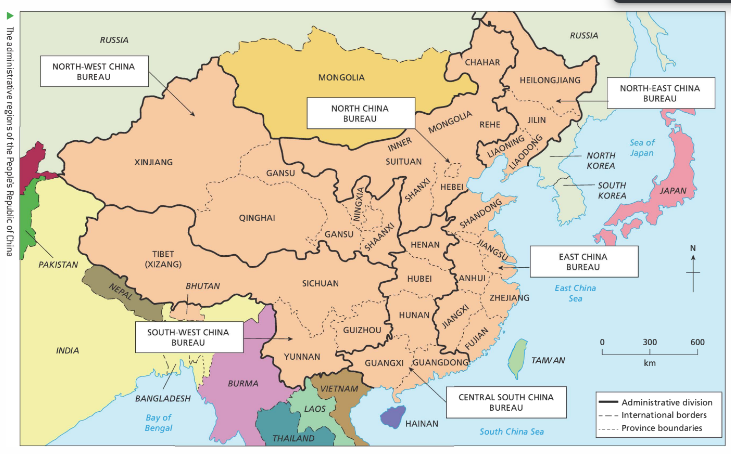
The Anti-movements
1951 Mao announcd “three-anti campaign”
1952 exteended to ‘“five-anti campaign”
3 anti targets:
Waste
Corruption
Inefficiency
5 anti campaign
industrial sabotage
tax evasion
bribery
fraud
theft of government property
Reactionaries and counter-revolutionaries
Those deemed to be remants of the “bureaucratic capitalist class”
Ie middle class bourgeosie
Mao regarded its destruction essential for revolution → only 1 class (proletariat)/ revolutionary workers would exist
Censorship + propaganda
Censorship rampant
Newspapers in 1949 advertised Communist propaganda
Communist rallies/slogans/songs advertised
very successful → people thought this was part of national transformation
Thought reform/ Re-education
In government offices, factories, workshops, schools + unis people were ‘re-educated’ needing to learn party doctrine / confess / admit past mistakes
The Great Terror
Household registration system → Could be family/ collective unit (factory dorm/ hospital department)
People were given class label ‘good’ ‘middle’ ‘bad’ on basis of party loyalty
Could be inherited → determine a persons fate and became key in ensuring conformity
Denounciation
Turning on ‘enemies’ of the revolution → high profile usually but also friends, children
Street had appointed watchers → Kept CCP informed by anyone suspicious
‘bad classes’ interrogated by police
Labour camps
Modelled after the Gulag → dated back to early days of CCP
“Counter'-revolutionaries” sentences to hard labour
1955 Camps had 2 million people (90% political prisoners
Poor working conditions
25~ million people died in Mao’s camps
Mass killings
Regime’s enemies were imprisoned/ executed/ interrogated/ kept under surveillance
CCP turned on gangs/ triads (secret societies) in a mass killing
Mao issued killing quotas → official figures come to light but many not recorded
Land reform
Land confiscated from landlords + resdistributed to peasants/ former tenants
“speak bitterness” campaigns + violence used to humiliate, punish + eliminate landlords as a class (2-3 million killed)
Villagers locked into cooperatives → easier to monopolise over supplies
Hunger + famine because of high state levies
1 party state
1949 - 10 seperate political parties (Left GMD, Democratic league + splinter parties)
All eliminated in political purges
National People’s Congress (NPC)
Responsible for deicding national policy (but actually party officials oversaw election process so anyone critical of Mao couldn’t stand)
Politburo
Leading members of CCP
Democratic centralism
Only leaders were educated in revolutionary science (i.e accepting ultimate authority of Mao)
The Korean War (1950-53)
North Korea (USSR) vs South Korea invasion (United States) in a war attempting to seize each other’s territory
Notion of Communism as a ‘monolithic’ force
Mao supported invasion but his priority was to pull in PLA for reunification campaigns in Tibet/ Liberation → he may have had a Taiwan invasion in mind + wanted to test Stalin’s resolve
China sent aid ~3 million
Campaigns to “resist America, aid Korea, preserve our homes, Defend the nation” → “Hate America” supported by relentless propaganda
Accused USA of germ warfare in Korea → CCP propaganda went into overdrive but 1953 concluded PRC allegations were false
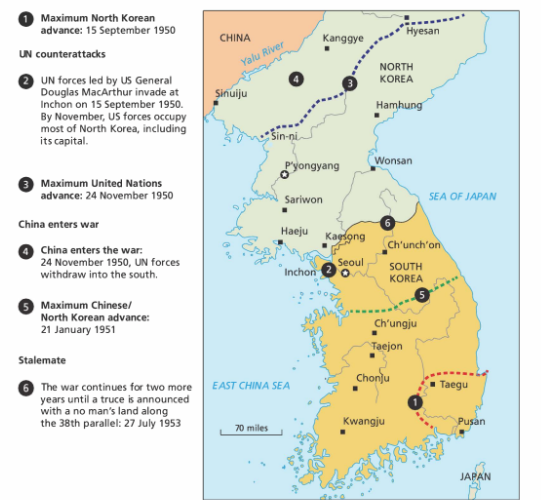
Zhou Enlai 1898-1976
Premier + Foreign Minister in 1949
Able diplomat → seen as a moderating influence during the Cultural revolution
Lin Biao 1907-1971
Communist military leader (played a key role in CCP Victory) → instrumental in creating Cult of Mao + Directing PLA during the cultural revolution
The impact of the Korean war on China
Claimed propaganda victory → blostered prestige at home/ abroad
China’s economy severely hit (1951, 55% of spending was millitary expenses)
Urban economy suffered + would require a decade to recover
Pressure to repay Stalin for Soviet Supplies
Party purges
Mao turned on 2 CCP leaders Gao Gang and Rao ShuShi → claimed they abused their positions + established ‘independent kingdoms’
Dismissed by the central councils
Witch-hunt followed as other leaders were denounced + sent to prison camps for “treachery” + splitting the party
→ reminder to tow the line
Mao’s grip on power (maintenance) 1955-1976
Cusp of political upheval
Mao wanted to fulfull ideals of revolution but paranoid about losing grip on China
The impact of de-Stalinisation
1956 - Nikita Khrushchev denounced Stalins ‘cult of personality’ → Speech affected soviet states and in china there was strikes + protestts in rural / urban areas
Mao interpreted it as denouncing ‘cult of personality’
1956 references to Mao Zedong though removed from CCP charter
The “Hundred Flowers” Campaign
Early 1957, slogan '“Let a hundred flowers bloom, let a hundred schools of thought contend” Our society cannot back down, it could only progress… criticism of the bureaucracy is pushing the government towards the better.’
Critics attacked party + Mao of corruption + lacking realism
Mao halted the campaign and launched an anti-rightist movement → force his critics to redact their criticisms, Deng Xiaoping led the campaign
Only way to escape denunciation was conformity
Outcome:
Mao strengthened position in party + country
Historiography regarding Hundred Flowers Campaign
Jung Chang argues it was a deliberate trick by Mao → Wider ploy to control party + society
Lei Feignon (US Scholar) revised it arguing he was more pragmatic. Wanted inefficiencies of bureaucracy to be identified
Jonathan Spence → argues it was the result of confusion in the party over the pace of industrial + agricultural reform
Purge of Peng Dehuai
Peng Dehuai PRC’s Minister of Defence openly spoke of famine caused by Great Leap forward
Was denounced bc criticism was treason
Tibetan Uprising 1959
Tibet rose against Chinese occupaion
Chinese authorities met nation uprising with suppression + mass arrests
Tibetan religion came under attack
20% of population imprisoned + half died in prison
Motives for the cultural revolution
1.) Power Struggle – After the GLF, Mao’s own political position was weakened and his economic policies rejected. He wanted to defeat his opponents and regain political supremacy.
2.) Purify Communism – Mao hated the development of a new CCP middle class which he saw as corrupt. He also labelled the economic reforms of moderates as ‘capitalist’ or ‘Revisionist’. Chinese culture also had to change.
3.) Education & Culture – Education was attacked as it produced this ‘bureaucratic class’. It needed to be more revolutionary, less academic. Traditional Chinese culture was seen as ‘Bourgeois’.
4.) Mao’s Comeback – Mao was confident enough to launch the Cultural Revolution as from 1965 he gained the support of Lin Biao and the PLA. He created the ‘Red Guards’ and used propaganda to ensure support.
Lu Shiaoqi (1898-1969)
Revolutionary succeeding Mao as President in 1959 → purge as Mao’s successor during the Cultural Revolution in 1968 + died in 1969 from harsh conditions
Chen Boda 1904-1989
Leading communist intellectual → helped Mao carve Maoist ideology
The Cultural revolution
1962 Mao retreated politically but growing popularity of Liu Shiaoqi and Deng Xiaoping caused him to reassert his authority
Mass political upheaval leading to genocide, class war, cultural destruction + economic chaos
Enabled Mao to be at forefront of CCP + undisputed leader of China
The Little Red Book
Compiled by Lin Biao in 1960s
Saying of Mao and became central to training PLA soldiers
750 million copies sold
Enshrined Mao as a cult leader, was a social necessity in schools + at home + became a vital point of reference in solving disputes
Rallies
18 August 1966 mass demonstration organised by Lin Biao + Chen Boda took place in Tiananmen Square. 1 mill + people waved little red book copies + chanted slogans
The red guards
groupings of college and secondary school students who embraced the cult of Mao and the aims of the Cultural Revolution
supported by the PLA under Marshal Lin Biao and Mao’s wife Jiang Qing
Mao denounced the ‘Four Olds’: old culture, ideas, customs and habits. Jiang Qing turned Mao’s slogan into a programme for eradication of traditional Chinese culture
A ‘Pretarian Culture’ was created and Lian Biao ordered the PLA not to oppose the Red Guards who attacked anything seen as ‘capitalist’ or ‘bourgeois’.
“If the proletariat does not occupy the positions in literature and art, the bourgeoisie certainly will.” - Lin Biao, Head of the PLA
Aug 1966 - Mao ordered them to ‘bombard the headquarters’ and attack the CCP from the top down. They soon went on the rampage
Children denounced their own parents as anti-Communist. Schools closed and many teachers were beaten and abused
By 1967 law & order had broken down as Red Guards fought ‘reactionaries’ with the death of over 400,000 across China.
“We are the critics of the old world; we are the builders of the new.”
Red guard targets
Sanctioned by Ministry of Public security + gave info on
Landlords
Rich peasants
reactionaries
bad elements
rightists
The ‘Four Olds’
Old ideas
Old culture
Old customs
Old habits
Attacks on moderates, Deng Xiaoping, Liu Shaoqi
CCP moderates removed/ targeted by Red Guards
Deng Xiaoping + Liu Shaoqi denounced as revisionists
PLA + Red guards movement to countryside
1968 Red guards getting out of hand
Industrial production affected
Schools + Unis shut down
Orders given from PLA to live among the peasants
Many were unprepared for the hardship and began to question their idealism/ Mao’s goodwill.
Historiography of the Cultural revolution
Long-term Cultural Factors - Cultural Revolution was a playing out of tensions behind the peasant uprisings that China had experienced from Han times onwards. Not enough to blame Mao or Lin Biao alone. Deeper examination of cultural and societal forces needed
Societal Pressures since 1949
Pre-Cultural Revolution social tensions led to the Red Guard violence. Students had to fight for dwindling opportunities. Abuse and violence grew as the students tried to show their devotion to the cause. They resented the subordinate status that had originally been placed upon them. Authoritarian personality characteristics that the Red Guards learned were powerfully linked to a new system of political socialisation that was based in the schools. The decline of the family as a socialisation agent was replaced by the authority of the state, and school-learned socialisation.
Power Struggle
Cultural Revolution limited political power and played a large part in the Post-Mao reforms in China. CR was not an abrupt break from the past but a continuation of a self-limitation of political authority that existed also in China’s traditional political system. CR and Red Guards were expressions of profound crisis in integration. In the struggle for power, two political forces divided the Chinese people and refused to be integrated. The use of violence WAS controlled, achieved the desired social change with the least disruptive effects.
Indoctrination and the Cult of Personality
Examined how the political upheaval affected people’s lives, challenging Tsou’s thesis. CR as tragedy not politics. Based largely on interviews with survivors conducted in 1981-82. CR surpassed only by the Nazi Holocaust. Explained Red Guard cruelty but stating that morality was a product of education, not inherent in nature. Cult of Mao elevated Mao to god, unquestioning faith and obedience. China had never been a society where individual judgement was encouraged. Role of the leader always more important than that of the individual. Mao’s power only served to enhance traditional subservience before authority.
Nature of Regime and Societal Pressures
The nature of Chinese politics was a system that bred both fear and compliance and made it possible for the mass campaigns of terror and intimidation. Red Guards viewed the CR as the struggle of one class to overthrow another. Blamed the frustrations of the Chinese students as a cause of the violence of the Cultural Revolution. Disillusioned students who were frustrated over policies that kept them from obtaining political advancement because of their family backgrounds fuelled the revolution. Millions of disgruntled urban students who had been relocated to the countryside during earlier campaigns. Mao used this to his advantage. Red Guards became the new vanguards of the revolution.
The Lin Biao Affair
Appears Lin feared for his life and plotted to remove Mao. Once leaked to Zhou Enlai, he made a desperate attempt to escape to USSR by plane but crashed in Mongolia and killing all on board
The Tiananmen incident
1976 Mao Zedong died
Jiang Qing
Wife of Mao
allowed Jiang to enter political fray in 1959 because she advocated Maoist thought
Would be a brutal enforcer of cultural reform + led ferocious attacks against “counter-revolutionairies
Foreign policy
Wanted China to gain recognition as a powerful independent state
Though inconsistent policies China remained independence
The Bandung Conference 1955
April 1955, representatives from 29 government of Asian & African nations gathered in Bandung, Indonesia to discuss peace + role of countries in the Cold war, economic development + decolonisation
China played important role
After Stalins death Mao appeared to be leader of communist world and non-Cold War aligned countries recognised him as leader of world stage
Sino-Soviet rift 1958-1976
Khrushchev post Stalins death wekned Mao’s position and contributed to the chaos of 100 flower’s campaign
Mao fearful of Soviet relations w West → Chinas subsequent isolation
Accused Khrushchev of revisionism + betraying the revolution
Tensions increased when both sides failed to find agreement, even when Khrushchev visited B eijing in 1 9 58. In that year, Mao was braced for war with Taiwan. In response, the USA prepared to retaliate, so Mao backed down, blaming the Soviets for not offering their
support. Khrushchev denounced the CCP as reckless. The PRC deliberately pursued policies against the USSR in Albania and
Yugoslavia. Diplomatic relations were severed at the Moscow C onference of 1 961, when Zhou Enlai and the C hinese delegation walked out. Fierce Sino-Soviet propaganda played on the bitter recriminations between
both countries, as each side jockeyed to humiliate the other on the world
stage. What was really at stake was which of the two powers would be
the leader of worldwide revolution.
By the mid- 1960s, all S oviet experts and advisers were withdrawn from the PRC . Despite this, C hina produced its first hydrogen bomb in 1 964 and, to the alarm of the S oviets, Mao announced his willingness to use it. Relations continued to deteriorate under Khrushchev's successor, Leonid Brezhnev. The lowest point in relations was in 1 969, when a relatively minor incident sparked a war on the Sino-Russian border. Only the threat of nuclear war ended the conflict.
The Sino-Soviet rift lasted until Mao's death in 1 976. His eventual successor, D eng Xiaoping, adopted a more tolerant approach to the USSR and the West.
Relations with the US
The CCP victory of 1 949 ushered in decades of tension with its traditional
western imperialist enemy, America. Anti-American campaigns intensified
during the Korean War and the C ultural Revolution. Tensions were
heightened by China's moral and diplomatic support of the USA's enemies
during the Vietnam War. Like Stalin, Mao always feared that the western
powers would launch an attack on China. He devised a defensive strategy
for China, known as the "Third Line". This was a plan for a vast network
of fortifications across China, both above and below ground, to withstand
heavy bombardment.
Mao steered China on a new course in 1 971, when he invited the US table tennis team to play in C hina. Zhou Enlai and Henry Kissinger steered negotiations, which became known as "ping-pong diplomacy".
By warming to the USA, Mao aimed to undermine the position of the USSR as a world power. He was also prompted to begin a Sino-American detente because the United Nations had accepted China's seat on the S ecurity Council. China now had the power of veto to block S oviet-initiated resolutions.
Mao invited President Nixon to China and greeted him in 1 972. This parting of the B amboo C urtain was a major diplomatic success for both former rival nations. Although much still divided the two countries, the PRC crept out of isolation. By 1 979 both countries had established full diplomatic relations.
Relations with other nations
Relations with the West showed little mutual respect. The UN heavily criticized Mao for his hardline policies in Tibet. Relations with Taiwan were always hostile and, despite Mao's attempts to regain Taiwan for the Chinese mainland, Taiwan has remained independent to this day.